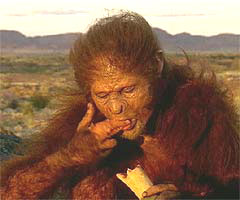 Last post, I lamented the fact that I spend most of my lunch looking forward to the next bite (and not tasting the present one). I blamed this habit on the role of dopamine in the ventral striatum: to anticipate rewards, work toward them, and focus attention on what’s next. Here’s a picture (a reconstruction, obviously, as cell phones lacked camera functions in those days) of Homo habilis having lunch. H. habilis lived about 2 million years ago, and is thought to be the first member of the Homo genus. In other words, he’s our direct ancestor, and no doubt our brains resemble his in many ways. Well, we have bigger frontal lobes. But…so what? How often do we use them to advantage while eating lunch? I use my frontal lobes to read the newspaper while having lunch, which is an elaborate way to avoid any contact with the taste of my food.
Last post, I lamented the fact that I spend most of my lunch looking forward to the next bite (and not tasting the present one). I blamed this habit on the role of dopamine in the ventral striatum: to anticipate rewards, work toward them, and focus attention on what’s next. Here’s a picture (a reconstruction, obviously, as cell phones lacked camera functions in those days) of Homo habilis having lunch. H. habilis lived about 2 million years ago, and is thought to be the first member of the Homo genus. In other words, he’s our direct ancestor, and no doubt our brains resemble his in many ways. Well, we have bigger frontal lobes. But…so what? How often do we use them to advantage while eating lunch? I use my frontal lobes to read the newspaper while having lunch, which is an elaborate way to avoid any contact with the taste of my food.
What does any of this have to do with the psychobiology of addiction? Goal anticipation equals craving when the goal is out of reach. This is a common state for addicts, even for recovering addicts. When the goal (let’s say more ribs) is in reach, then the dopamine surge simply directs you take more. The theory I follow for understanding the addicted brain divides motivated behaviour and pleasure into two distinct functions: wanting and liking. This theory has been proposed and defended by Berridge and his colleagues for over 10 years, and as far as I can see, it beats other theories hands-down. According to Berridge, wanting is subserved by striatal dopamine, and liking is subserved by…you guessed it…opioids. I cover all this in detail in my book, but the thumbnail version is this: When you like something (and get a rush of endogenous opioids), it is adaptively important to get more of it. That requires wanting. Opioids make you feel good, but they also increase dopamine flow to the ventral striatum (from the VTA, ventral tegmental area, in the midbrain). So dopamine takes over from opioids, by which means wanting takes over from liking. Your brain lurches into gear: where will I find more? how will I get it? I can’t wait! The symptoms of craving are obvious.
Our ancestor, whose mesolimbic dopamine system was pretty much exactly the same as ours, looks to me as if he’s saying: “Hmmm, not bad, tastes pretty good. Where can I get more…?” He’s just at the shift point from liking to wanting. Look at the creases in his brow. I’ll bet you he’s already thinking about the next bite.
Leave a Reply